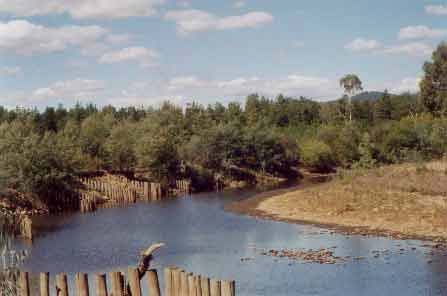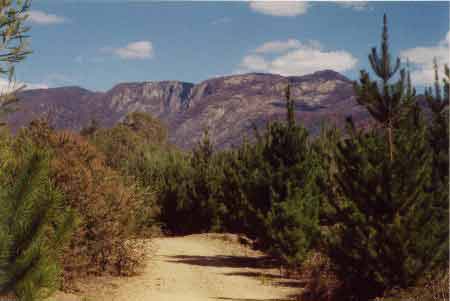Legal Number: LEGL/93-124/1Plantation: Braithwaites & JunctionConservation Priority: Med |
| Herbicide | Label Rate max as kg/ha | Used to control | Notes | Application |
| Carfentrazone-Ethyl | 0.036 | |||
| Clopyralid | 2.55 | Woody Weeds | Highly Toxic/Potential Ground water Contaminant | air or ground |
| Glyphosate | 3.6 | Herbaceous and woody weeds, noxious weeds | ||
| Hexazinone | 4 | Woody Weeds | Ground Water Contaminant | Aerial, ground, spot |
| Metsulfuron-Methyl | 0.06 | Woody Weeds, Noxious Weeds | Potential Ground Water Contaminant | Aerial, ground or spot |
| Triclopyr | 3 | Woody and Noxious Weeds | Ground, spot, basal bark |
Declared Water Catchment Area: This
plantation area is located in the Ovens River (Wangaratta) Water Supply
Catchment.

93-124: This photo shows the close proximity of the plantation to the Ovens River.
MURRAY RIVER SUPPLIES WATER TO YARRAWONGA, COBRAM, BARMAH, ECHUCA ,
KERANG, PIANGIL, SWAN HILL, ROBINVALE, MILDURA
THREATENED FISH NOTES - OVENS RIVER: Most important river in
Victoria in regard to the survival of the Murray
Cod. Murray
Cod spawn almost as far up as Myrtleford
and the Ovens supplies recruitment for the Murray River as well. The
Ovens has no dams and is a river of extreme national significance. Trout
Cod are now being found in the Ovens
and may set up a self sustaining spawning population. Trout
Cod have been successfully stocked into
Ovens and upper Ovens, downstream of Myrtleford and going up the King
River - past Moyhu. All the tribs of the Ovens are important for native
fish including King, Buffalo and Buckland Rivers.
Responsible Authority: Alpine Shire Council
Plantation Catchment: Plantations run along banks of Ovens River
and Buckland River..
Catchment Managment Authority: North East Catchment Management
Authority.

93-124: Shot of Braithwaite plantation and Mount Buffalo as the impressive 'backdrop'.
Hancock Watch Visit 03: This LEGL is actually two seperate plantations (Braithwaite and Junction) located approximately 2 & 3 km's north west of the settlement of Porepunkah. Both plantations lie in very close proximity to the Ovens River - Braithwaite on the north bank, Junction on the south bank Junction actually sits immediately downstream from the junction of the Ovens and Buckland Rivers.
Because these plantations are located on riverflats, slope problems do not occur here. We visited the Braithwaite plantation. Some logging had taken place several years ago on the western portion of the plantation. The only issue of concern was that the plantation is located almost on the banks of the Ovens River. Major flood events could wash sediment and herbicides/fertilisers into the river post logging. The risks of this occurring are limited, but possible. For this reason we have given these plantations a medium conservation importance.
“Special Investigation: North-Eastern Victoria - Ovens Softwood Plantation Zone. Land Conservation Council 1981.
p12 The northern plains region The north-west of the
study area towards Wangaratta contains part of the extensive riverine
plains. The plains, which border the major streams such as the King
and Ovens Rivers and their tributaries, consist of alluvial deposits,
often more than 50m deep. Alluvial fans occur along the foothill margins,
and features such as river terraces and ox-bow lakes, typical of a riverine
flood plain occur along the major river valleys. The river terraces
are characterised by uniform sandy loams and gradational soils, while
the alluvial sediments of the fllod plain are duplex soils, usually
consisting of a sandy loam overlying a clay subsoil. These soils are
found in all major river valleys throughout the study area. . .”
Ovens River: The rivers all flow north, from heavily forested
mountain country through excessive river flats to the Murray River.
Murray cod populations close to the Murray River. Small river blackfish
are common in many rivers, Macquarie Perch are still occasionally caught,
and catches of golden perch are also being reported. Brown trout widely
distributed through system with rainbow trout most abundant in upper
reaches. Upstream from Myrtleford - Brown Trout to 1.3kg, some rainbow
trout, small redfin and river blackfish.
Source: A Guide to the Inland Angling Waters of Victoria by BR Tunbridge,
PL Rogan, CA Barnham. Department Conservation and Environment. Arthur
Rylah Institute for Environmental Research, 123 Brown St, Heidelberg,
3084. (4th ed - 1991)
HOME
